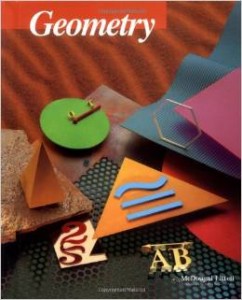There is some debate over the study of geometry with and without proof. Here is the perspective of someone who has been teaching geometry in a variety of educational settings (public school, homeschool co-op, and online classical Christian school) and from several different textbooks (including Jurgensen/Brown, Jacobs, and Larson/Boswell/Stiff ) over the last 25 years:
To make a familiar comparison, consider studying scripture. If you take a passage of scripture and delve deeply into the etymology of the passage and cross-reference as much as possible, you will know a lot about the origin and often the language-oriented meaning of the passage, and you may be building new knowledge on the foundation of previous knowledge. However, if that is as far as the study goes, you only will know a lot about the scripture; it is not making any impact or change in your life. Conversely, if someone tells you the life application of a passage, but you don’t have any basis for knowing why the passage was included, how it relates to other scripture, or why it is important, you may live out the truth for a while but the significance of it will wane without the support of meaning behind it. We are commanded to “…be doers of the word and not hearers [thinkers] only…”(James 1:22; emphasis mine) with the implication that hearing (thinking) and doing work together.
The same could be said of the study of geometry. The use of proof is for the purpose of thinking about geometry, making connections between new material and the foundation of material already studied, and understanding the “whys”. Also, students have the opportunity to use the processes of logic and argument that are foundational in classical education. Application problems, on the other hand, are used for doing geometry—taking the concepts and applying them in different situations. Too much proof without enough application results in students who know a great deal about geometry without having any idea what to do with the knowledge. Too much application without enough proof results in students who “do” geometry without understanding, and are only able to apply the processes to familiar problem situations. The key to a great geometry program is finding the balance between the two.
The text Geometry, by Jurgensen, Brown, Jurgensen, is one which creates this balance. A frequent concern from parents is that this course of study is “rigorous.” I agree that it is rigorous in the sense that it presents a college preparatory course in geometry that will leave students well-prepared for the geometry they will encounter on college entrance exams as well as in upper level mathematics courses such as pre-calculus and calculus. However, I do not agree that it is rigorous in the sense of “inaccessible.” I have taught from this text in both public school and homeschool co-op settings with pleasing results from a variety of students with varying mathematics aptitudes. Do some students have to work harder than others in order to succeed? Yes, but that is true with all mathematics textbooks. Is the effort, even if extra, worth it? Yes, in terms of the preparation for future mathematics testing and coursework.
Submitted by Leslie Smith, WHA Math Instructor
